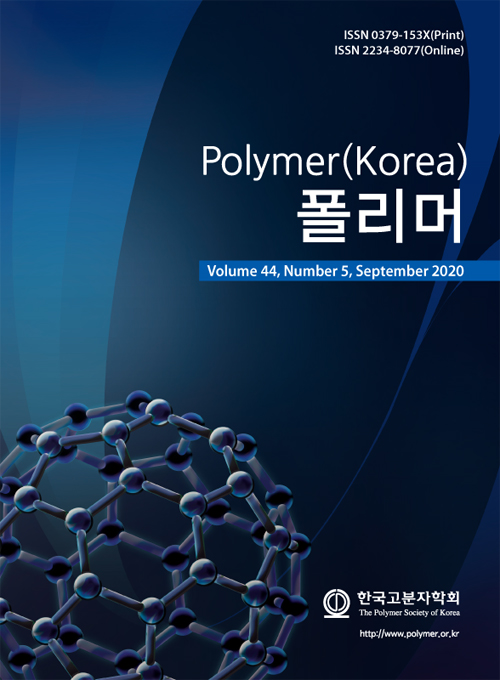- Polypropylene Composite with Aminated Cellulose Nanocrystal
School of Chemical and Biological Engineering, Seoul National University, Seoul 08826, Korea
*Department of Application and Development, S-Oil TS&D center, Seoul 07795, Korea- 아민화 셀룰로오스 나노크리스탈 함유 폴리프로필렌 복합재료
서울대학교 공과대학 화학생물공학부, *㈜에쓰-오일
To improve the interfacial
strength and mechanical properties of polypropylene (PP)/cellulose nanocrystal
(CNC) composites, CNC was functionalized with (3-aminopropyl)triethoxysilane
(APTES). During the preparation of the composites via melt mixing,
maleic anhydride-grafted polypropylene (MAPP) was also used as a
compatibilizer. The functionalization of CNC was analyzed through the Fourier
transform infrared (FTIR) spectroscopy, 13C solid-state nuclear
magnetic resonance (NMR) spectroscopy, and X-ray photoelectron spectroscopy
(XPS), through which CNC appeared to be functionalized by forming covalent bond
with APTES. The changes in morphology and mechanical properties by the addition
of functionalized CNC and MAPP were investigated. SEM observation of the
composites showed that the addition of MAPP improved the dispersion state of
the CNC particles by improving the interfacial interaction between the filler
and the matrix. The flexural modulus and strength of the PP/CNC composites
increased by as large as 28% and 18%, respectively, by amine-functionalization
of CNC.
폴리프로필렌(PP)/셀룰로오스
나노크리스탈(CNC) 복합재료 내 CNC의 분산성을 향상시키기
위해 CNC를
(3-aminopropyl)triethoxysilane(APTES)로 개질하였다. 복합재료는
용융 혼합 방법으로 제작되었고, 무수말레인산이 수식된 폴리프로필렌(MAPP)을
상용화제로 사용하였다. CNC의 개질 여부는 적외선 분광학, 광전자분광법, 고체상 13C
핵자기공명분석법을 사용하였으며, 각각의 스펙트럼을 통해
APTES가 CNC 표면에 수식된 것을 확인하였다. 개질된 CNC와 MAPP 상용화제의
첨가로 인해 변화되는 PP/CNC 복합재료의 형태구조 및 기계적 성질을 확인하였다. SEM을 이용한 복합재료의 형태구조를 분석한 결과, MAPP가
첨가됨에 따라 충전제와 기지재 사이의 계면 상호작용이 향상되어 CNC 입자의 분상성이 향상되었다. PP/아민화 CNC 복합재료의 경우, PP/CNC 복합재료에 비해 굴곡 탄성률 및 강도가 향상된 결과를 나타내었다.
Keywords: polypropylene, cellulose nanocrystal, composite, mechanical properties
- Polymer(Korea) 폴리머
- Frequency : Bimonthly(odd)
ISSN 0379-153X(Print)
ISSN 2234-8077(Online)
Abbr. Polym. Korea - 2023 Impact Factor : 0.4
- Indexed in SCIE
 This Article
This Article
-
2020; 44(5): 734-740
Published online Sep 25, 2020
- 10.7317/pk.2020.44.5.734
- Received on Jun 2, 2020
- Revised on Jun 5, 2020
- Accepted on Jun 5, 2020
 Correspondence to
Correspondence to
- Jae Young Jho
-
School of Chemical and Biological Engineering, Seoul National University, Seoul 08826, Korea
- E-mail: jyjho@snu.ac.kr









 Copyright(c) The Polymer Society of Korea. All right reserved.
Copyright(c) The Polymer Society of Korea. All right reserved.